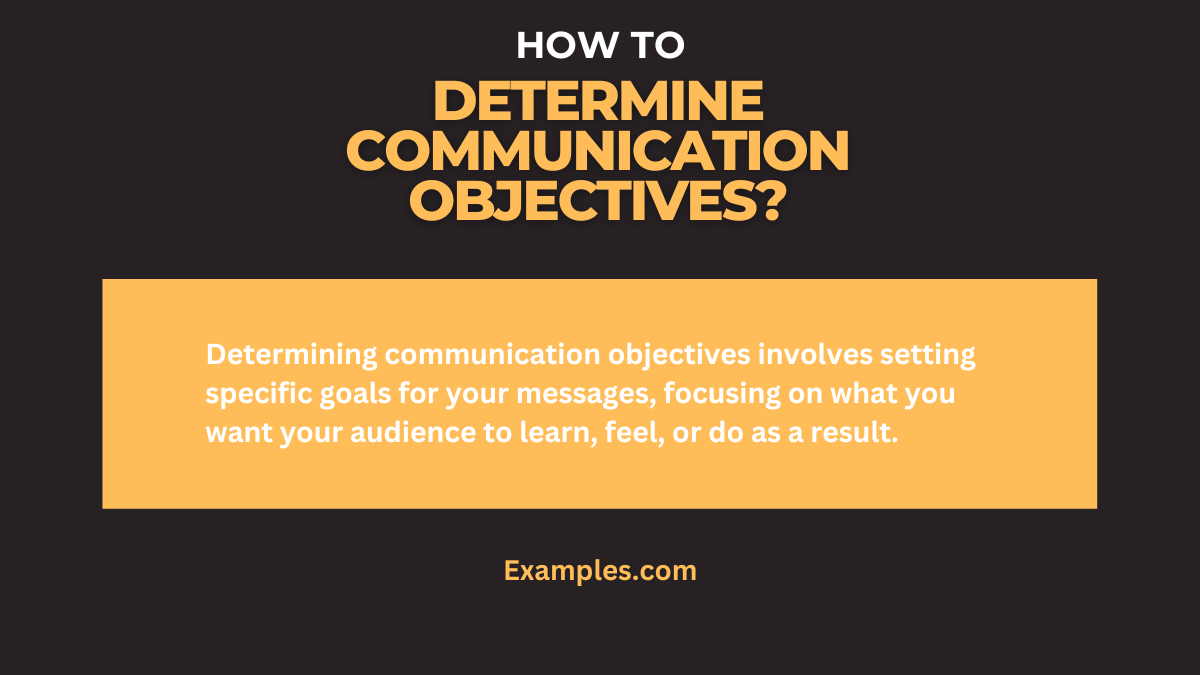How to Determine Communication Objectives?
Step into the world of strategic communication with our definitive guide on How to Determine Communication Objectives. This guide, sprinkled with practical Communication Objective Examples, is designed to help you identify and set clear, impactful goals for your communication efforts. Whether you’re aiming to enhance business strategies, improve marketing campaigns, or boost personal interactions, our guide provides essential tips and examples to shape your communication objectives effectively, making them powerful tools for success.
How to Determine Communication Objectives?

Determining communication objectives means setting clear goals for your messages. It’s deciding what you want your audience to learn, feel, or do after they hear or read your communication. Whether it’s sharing information dissemination communication objective or inspiring action behavior change communication objective, setting these objectives helps focus your message, making it more effective and aligned with your overall aims. This clarity is essential in all forms of communication, from business to personal interactions.
20 How to Determine Communication Objectives Examples
When setting communication objectives, it’s crucial to have clear, achievable goals that guide your messaging strategy. This involves tailoring your objectives to specific needs and situations. From enhancing brand awareness to fostering employee engagement, each objective requires a unique approach. Here are 20 unique and distinct examples, each accompanied by an explanation and Example sentences, illustrating how to effectively communicate these objectives.

- Awareness Building Communication Objective: Aim to increase awareness about a new product or service.
Example: “Our campaign will focus on introducing our innovative product and highlighting its unique features to our target audience.” - Information Dissemination Communication Objective: Share important information or updates.
Example: “We need to ensure that all employees are informed about the new company policies by utilizing multiple communication channels.” - Persuasion Communication Objective: Convince the audience to adopt a new viewpoint or behavior.
Example: “Our message should compellingly present the benefits of sustainable practices to persuade consumers to make eco-friendly choices.” - Brand Reinforcement Communication Objective: Strengthen the audience’s perception of your brand.
Example: “Our communication should consistently reflect our brand values and the high quality of our services.” - Relationship Building Communication Objective: Establish and nurture relationships with stakeholders.
Example: “We’ll use personalized communication to connect with our clients and build long-term partnerships.” - Audience Engagement Communication Objective: Engage your audience actively.
Example: “Let’s create interactive content that encourages audience participation and feedback.” - Reputation Management Communication Objective: Manage and improve the public perception of your organization.
Example: “In response to recent events, our communication should focus on reinforcing our commitment to customer satisfaction and transparency.” - Behavior Change Communication Objective: Encourage a change in behavior among your audience.
Example: “Our campaign will aim to influence healthier lifestyle choices through educational messages and motivational stories.” - Feedback Generation Communication Objective: Elicit feedback or opinions from your audience.
Example: “We should encourage our customers to provide feedback on our services through surveys and social media interactions.” - Crisis Communication Objective: Effectively communicate during a crisis to manage the situation.
Example: “In a crisis, our priority is to communicate clearly, honestly, and promptly to maintain trust with our stakeholders.” - Employee Motivation Communication Objective: Boost morale and motivation among employees.
Example: “Our internal communications should focus on recognizing employee achievements and reinforcing our shared goals.” - Market Positioning Communication Objective: Position your brand effectively in the market.
Example: “We must communicate the unique advantages of our products to differentiate ourselves in a competitive market.” - Sales Enhancement Communication Objective: Increase sales through targeted communication.
Example: “Our sales strategy should include persuasive messages that highlight the value and benefits of our offerings.” - Stakeholder Trust Building Communication Objective: Build and maintain trust with key stakeholders.
Example: “Regular, transparent communication is key to sustaining trust with our investors and partners.” - Educational Communication Objective: Educate your audience about a specific topic or issue.
Example: “Our content should be informative and accessible, aiming to increase understanding and awareness about environmental conservation.” - Leadership Communication Objective: Establish leadership and authority in your field.
Example: “By sharing our expertise and insights, we can position ourselves as thought leaders in the industry.” - Knowledge Communication Objective: Disseminate knowledge or information effectively.
Example: “We need to use clear, jargon-free language to ensure our research findings are understandable to a broader audience.” - Communication Objectives for Therapy: Support therapeutic goals through communication.
Example: “In therapy, our communication should be empathetic and supportive, facilitating patient progress.” - Communication Objectives for Treatment Plans: Communicate treatment plans clearly to patients.
Example: “It’s important to explain treatment plans in a way that is easy for patients to understand and follow.” - Digital Marketing Communication Objective: Leverage digital platforms for marketing.
Example: “Our digital marketing should be dynamic and engaging, utilizing various online platforms to reach our target audience effectively.”
Each of these objectives requires a tailored communication strategy, ensuring that the message is not only heard but also resonates with the intended audience, driving the desired outcomes.
How to Determine Communication Objectives in Business
Determining communication objectives in business is crucial for effective corporate messaging. This process ensures that your business communication strategies are not only aligned with your company goals but also resonate with your intended audience.
- Assess Business Needs: Begin by understanding your business’s core needs. Are you focusing on brand reinforcement communication objective or stakeholder trust building communication objective? This clarity is essential.
- Define Target Audience: Who are your communication efforts aimed at? Identifying whether it’s internal communication, like employee motivation communication objectives, or external, such as market positioning communication objective, is key.
- Set Specific Goals: Your communication objectives in business should be specific and measurable. For instance, an objective can be increasing customer engagement by 20% over the next quarter.
- Choose Appropriate Channels: Select the most effective channels for your message, whether it’s digital platforms for a digital marketing communication objective or traditional media for wider reach.
- Create a Timeline: Implementing a timeline for your communication campaign objectives is crucial for tracking progress and ensuring timely execution.
- Evaluate and Adapt: Regularly assess the effectiveness of your communication strategies. Are they meeting your communication training objectives or management communication objectives?
By incorporating these steps, businesses can ensure that their communication objectives are well-defined, strategically aligned, and effectively executed.
How do you Determine Marketing Communication Objectives?
Determining marketing communication objectives is a vital step in crafting successful marketing strategies. These objectives should be intricately linked to both your overall marketing strategy and the specific needs of your target audience.
- Understand Market Dynamics: Gauge your position in the market. Are your communication objectives aligned with your digital marketing communication objective or more traditional marketing approaches?
- Highlight USP: Your marketing communication should spotlight your Unique Selling Proposition. This clarity helps in formulating effective communication objectives in advertising.
- Audience Segmentation: Tailor your communication to different audience segments. This could range from social media marketing communication objectives for younger audiences to more direct methods for others.
- Set Achievable Targets: Establish SMART goals, like improving online engagement or increasing newsletter subscriptions, aligning them with broader communication objectives in marketing.
- Opt for Effective Channels: Whether it’s online platforms for digital marketing or offline channels, choosing the right medium is crucial for reaching your target audience effectively.
- Content Strategy Development: Align your content with your marketing objectives, ensuring it addresses the needs and interests of your audience.
- Continuous Evaluation: Regularly assess your marketing efforts. Are they meeting your strategic communication objectives and adapting to changing market trends?
Incorporating these methodologies will ensure that your marketing communication objectives are well-defined, strategically sound, and poised for success.
Effectively determining communication objectives is key to successful messaging in any context. By clearly understanding and implementing strategic goals, whether in business, marketing, or personal interactions, you can ensure your communication is impactful and goal-oriented. This guide offers essential tips for crafting these objectives, ultimately enhancing the effectiveness and clarity of your communication efforts.



